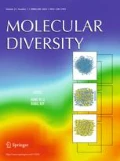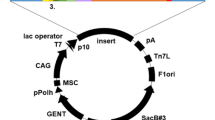Abstract
Nowadays, antibiotic resistance has turned into one of the most important worldwide health problems. Biological end point of critical enzymes induced by potent inhibitors is recently being considered as a highly effective and popular strategy to defeat antibiotic-resistant pathogens. For instance, the simple but critical β-carbonic anhydrase has recently been in the center of attention for anti-pathogen drug discoveries. However, no β-carbonic anhydrase selective inhibitor has yet been developed. Available β-carbonic anhydrase inhibitors are also highly potent with regard to human carbonic anhydrases, leading to severe inevitable side effects in case of usage. Therefore, developing novel inhibitors with high selectivity against pathogenic β-carbonic anhydrases is of great essence. Herein, for the first time, we have conducted a proteochemometric study to explore the structural and the chemical aspects of the interactions governed by bacterial β-carbonic anhydrases and their inhibitors. We have found valuable information which can lead to designing novel inhibitors with better selectivity for bacterial β-carbonic anhydrases.







Similar content being viewed by others
References
Capasso C, Supuran CT (2016) An overview of the carbonic anhydrases from two pathogens of the oral cavity: streptococcus mutans and Porphyromonas gingivalis. Curr Top Med Chem 16:2359–2368
Ozensoy Guler O, Capasso C, Supuran CT (2016) A magnificent enzyme superfamily: carbonic anhydrases, their purification and characterization. J Enzyme Inhib Med Chem 31:689–694
Capasso C, Supuran CT (2015) Bacterial, fungal and protozoan carbonic anhydrases as drug targets. Expert Opin Ther Targets 19:1689–1704
Del Prete S, De Luca V, De Simone G, Supuran CT, Capasso C (2016) Cloning, expression and purification of the complete domain of the η-carbonic anhydrase from Plasmodium falciparum. J Enzyme Inhib Med Chem 31:54–59
Del Prete S, Vullo D, Fisher GM, Andrews KT, Poulsen SA, Capasso C et al (2014) Discovery of a new family of carbonic anhydrases in the malaria pathogen Plasmodium falciparum—The η-carbonic anhydrases. Bioorg Med Chem Lett 24:4389–4396
Supuran CT, Capasso C (2015) The η-class carbonic anhydrases as drug targets for antimalarial agents. Expert Opin Ther Targets 19:551–563
Supuran CT (2013) Carbonic anhydrases: from biomedical applications of the inhibitors and activators to biotechnological use for CO2 capture. Med Chem 28:229–230
Bejaoui M, Pantazi E, De Luca V, Panisello A, Folch-Puy E, Hotter G et al (2015) Carbonic anhydrase protects fatty liver grafts against ischemic reperfusion damage. PLoS One 10:1–16
Del Prete S, Vullo D, Osman SM, AlOthman Z, Supuran CT (2017) Sulfonamide inhibition profiles of the β-carbonic anhydrase from the pathogenic bacterium Francisella tularensis responsible of the febrile illness tularemia. Bioorg Med Chem 25:3555–3561
Vullo D, Del Prete S, Di Fonzo P, Carginale V, Donald WA, Supuran CT et al (2017) Comparison of the sulfonamide inhibition profiles of the β-and γ-carbonic anhydrases from the pathogenic bacterium Burkholderia pseudomallei. Molecules 22:421–435
Gillard JJ, Laws TR, Lythe G, Molina-París C (2014) Modeling early events in Francisella tularensis pathogenesis. Front Cell Infect Microbiol 11:169–178
Saslaw S, Eigelsbach HT, Prior JA, Wilson HE, Carhart S (1961) Tularemia vaccine study: II. Respiratory challenge. Arch Intern Med 107:702–714
Celli J, Zahrt TC (2013) Mechanisms of Francisella tularensis intracellular pathogenesis. Cold Spring Harb Perspect Med 3:a010314–a010327
Oyston PC (2008) Francisella tularensis: unravelling the secrets of an intracellular pathogen. J Med Microbiol 57:921–930
Conlan JW (2011) Francisella tularensis: a red-blooded pathogen. J Infect Dis 204:6–8
Currie BJ (2010) Burkholderia pseudomallei and Burkholderia mallei: melioidosis and glanders. In: Mandell, Douglas and Bennett’s Principles and Practice of Infectious Diseases. Churchill Livingstone Elsevier, Philadelphia, pp 2869–2885
Stephens DP, Thomas JH, Ward LM, Currie BJ (2016) Melioidosis causing critical illness: a review of 24 years of experience from the Royal Darwin Hospital ICU. Crit Care Med 44:1500–1505
Cheng AC, Limmathurotsakul D, Chierakul W, Getchalarat N, Wuthiekanun V, Stephens DP et al (2007) A randomized controlled trial of granulocyte colonystimulating factor for the treatment of severe sepsis due to melioidosis in Thailand. Clin Infect Dis 45:308–314
Prusis P, Muceniece R, Andersson P, Post C, Lundstedt T, Wikberg JE (2001) PLS modeling of chimeric MS04/MSH-peptide and MC 1/MC 3-receptor interactions reveals a novel method for the analysis of ligand–receptor interactions. Biochim Biophys Acta 1544:350–357
Lapinsh M, Prusis P, Lundstedt T, Wikberg JE (2002) Proteochemometrics modeling of the interaction of amine G-protein coupled receptors with a diverse set of ligands. Mol Pharmacol 61:1465–1475
Lapinsh M, Prusis P, Uhlén S, Wikberg JE (2005) Improved approach for proteochemometrics modeling: application to organic compound-amine G protein-coupled receptor interactions. Bioinformatics 21:4289–4296
Prusis P, Lapins M, Yahorava S, Petrovska R, Niyomrattanakit P, Katzenmeier G et al (2008) Proteochemometrics analysis of substrate interactions with dengue virus NS3 proteases. Bioorg Med Chem 16:9369–9377
Lapins M, Eklund M, Spjuth O, Prusis P, Wikberg JE (2008) Proteochemometric modeling of HIV protease susceptibility. BMC Bioinf 9:181–191
Lapins M, Wikberg JE (2010) Kinome-wide interaction modelling using alignment-based and alignment-independent approaches for kinase description and linear and non-linear data analysis techniques. BMC Bioinf 11:339–353
Subramanian V, Prusis P, Pietilä LO, Xhaard H, Wohlfahrt G (2013) Visually interpretable models of kinase selectivity related features derived from field-based proteochemometrics. J Chem Inf Model 53:3021–3030
Rasti B, Karimi-Jafari MH, Ghasemi JB (2016) Quantitative Characterization of the Interaction Space of the Mammalian Carbonic Anhydrase Isoforms I, II, VII, IX, XII, and XIV and their Inhibitors. Using the Proteochemometric Approach. Chem Biol Drug Des 88:341–353
Rasti B, Namazi M, Karimi-Jafari MH, Ghasemi JB (2017) Proteochemometric modeling of the interaction space of carbonic anhydrase and its inhibitors: an assessment of structure-based and sequence-based descriptors. Mol Info 36:1600102–1600113
Rasti B, Entezari Heravi Y (2018) Probing the chemical interaction space governed by 4-aminosubstituted benzenesulfonamides and carbonic anhydrase isoforms. Res Pharm Sci 13:192–204
Simeon S, Spjuth O, Lapins M, Nabu S, Anuwongcharoen N, Prachayasittikul V et al (2016) Origin of aromatase inhibitory activity via proteochemometric modeling. PeerJ 4:e1979–e2006
Rasti B, Shahangian SS (2018) Proteochemometric modeling of the origin of thymidylate synthase inhibition. Chem Biol Drug Des 91:1007–1016
Rasti B, Schaduangrat N, Shahangian SS, Nantasenamat C (2017) Exploring the origin of phosphodiesterase inhibition via proteochemometric modeling. RSC Adv 7:28056–28068
Version, S., 6.9, Tripos Associates, St. Louis, Mo, 2001
Pastor M, Cruciani G, McLay I, Pickett S, Clementi S (2000) GRid-INdependent descriptors (GRIND): a novel class of alignment-independent three-dimensional molecular descriptors. J Med Chem 43:3233–3243
Duran A, Martinez GC, Pastor M (2008) Development and validation of AMANDA, a new algorithm for selecting highly relevant regions in molecular interaction fields. J Chem Inf Model 48:1813–1823
Wold S, Jonsson J, Sjörström M, Sandberg M, Rännar S (1993) DNA and peptide sequences and chemical processes multivariately modelled by principal component analysis and partial least-squares projections to latent structures. Ana Chim Acta 277:239–253
Hellberg S, Sjoestroem M, Skagerberg B, Wold S (1987) Peptide quantitative structure-activity relationships, a multivariate approach. J Med Chem 30:1126–1135
Sandberg M, Eriksson L, Jonsson J, Sjöström M, Wold S (1998) New chemical descriptors relevant for the design of biologically active peptides. A multivariate characterization of 87 amino acids. J Med Chem 41:2481–2491
Beasley D, Bull DR, Martin RR (1993) An overview of genetic algorithms: part 1, fundamentals. University computing 15:56–69
Rogers D, Hopfinger AJ (1994) Application of genetic function approximation to quantitative structure-activity relationships and quantitative structure-property relationships. J Chem Inf Comput Sci 34:854–866
Hou TJ, Wang JM, Liao N, Xu XJ (1999) Applications of genetic algorithms on the structure—activity relationship analysis of some cinnamamides. J Chem Inf Comput Sci 39:775–781
Kennard RW, Stone LA (1969) Computer aided design of experiments. Technometrics 11:137–148
Gramatica P (2007) Principles of QSAR models validation: internal and external. Mol Inf 26:694–701
Tropsha A, Gramatica P, Gombar VK (2003) The importance of being earnest: validation is the absolute essential for successful application and interpretation of QSPR models. Mol Inf 22:69–77
Eriksson L, Jaworska J, Worth AP, Cronin MT, McDowell RM, Gramatica P (2003) Methods for reliability and uncertainty assessment and for applicability evaluations of classification-and regression-based QSARs. Environ Health Perspect 111:1361–1375
Alhanout K, M Rolain J, M Brunel J (2010) Squalamine as an example of a new potent antimicrobial agents class: a critical review. Curr Med Chem 17:3909–3917
Gaynor M, Mankin AS (2003) Macrolide antibiotics: binding site, mechanism of action, resistance. Curr Top Med Chem 3:949–960
Khelaifia S, Drancourt M (2012) Susceptibility of archaea to antimicrobial agents: applications to clinical microbiology. Clin Microbiol Infect 18:841–848
Supuran CT (2017) Advances in structure-based drug discovery of carbonic anhydrase inhibitors. Expert Opin Drug Discov 12:61–88
Supuran CT (2016) Drug interaction considerations in the therapeutic use of carbonic anhydrase inhibitors. Expert Opin Drug Metab Toxicol 12:423–431
Capasso C, Supuran CT (2015) An overview of the selectivity and efficiency of the bacterial carbonic anhydrase inhibitors. Curr Med Chem 22:2130–2139
Capasso C, Supuran CT (2014) Sulfa and trimethoprim-like drugs–antimetabolites acting as carbonic anhydrase, dihydropteroate synthase and dihydrofolate reductase inhibitors. J Enzyme Inhib Med Chem 29:379–387
Capasso C, Supuran CT (2013) Anti-infective carbonic anhydrase inhibitors: a patent and literature review. Expert Opin Ther Pat 23:693–704
Nishimori I, Onishi S, Takeuchi H, Supuran CT (2008) The α and β classes carbonic anhydrases from Helicobacter pylori as novel drug targets. Curr Pharm Des 14:622–630
Morishita S, Nishimori I, Minakuchi T, Onishi S, Takeuchi H, Sugiura T et al (2008) Cloning, polymorphism, and inhibition of β-carbonic anhydrase of Helicobacter pylori. J Gastroenterol 43:849–857
Abuaita BH, Withey JH (2009) Bicarbonate induces Vibrio cholerae virulence gene expression by enhancing ToxT activity. Infect Immun 77:4111–4120
Author information
Authors and Affiliations
Corresponding author
Ethics declarations
Conflict of interest
All authors declare that they have no conflict of interest.
Electronic supplementary material
Below is the link to the electronic supplementary material.
Rights and permissions
About this article
Cite this article
Rasti, B., Mazraedoost, S., Panahi, H. et al. New insights into the selective inhibition of the β-carbonic anhydrases of pathogenic bacteria Burkholderia pseudomallei and Francisella tularensis: a proteochemometrics study. Mol Divers 23, 263–273 (2019). https://doi.org/10.1007/s11030-018-9869-5
Received:
Accepted:
Published:
Issue Date:
DOI: https://doi.org/10.1007/s11030-018-9869-5




